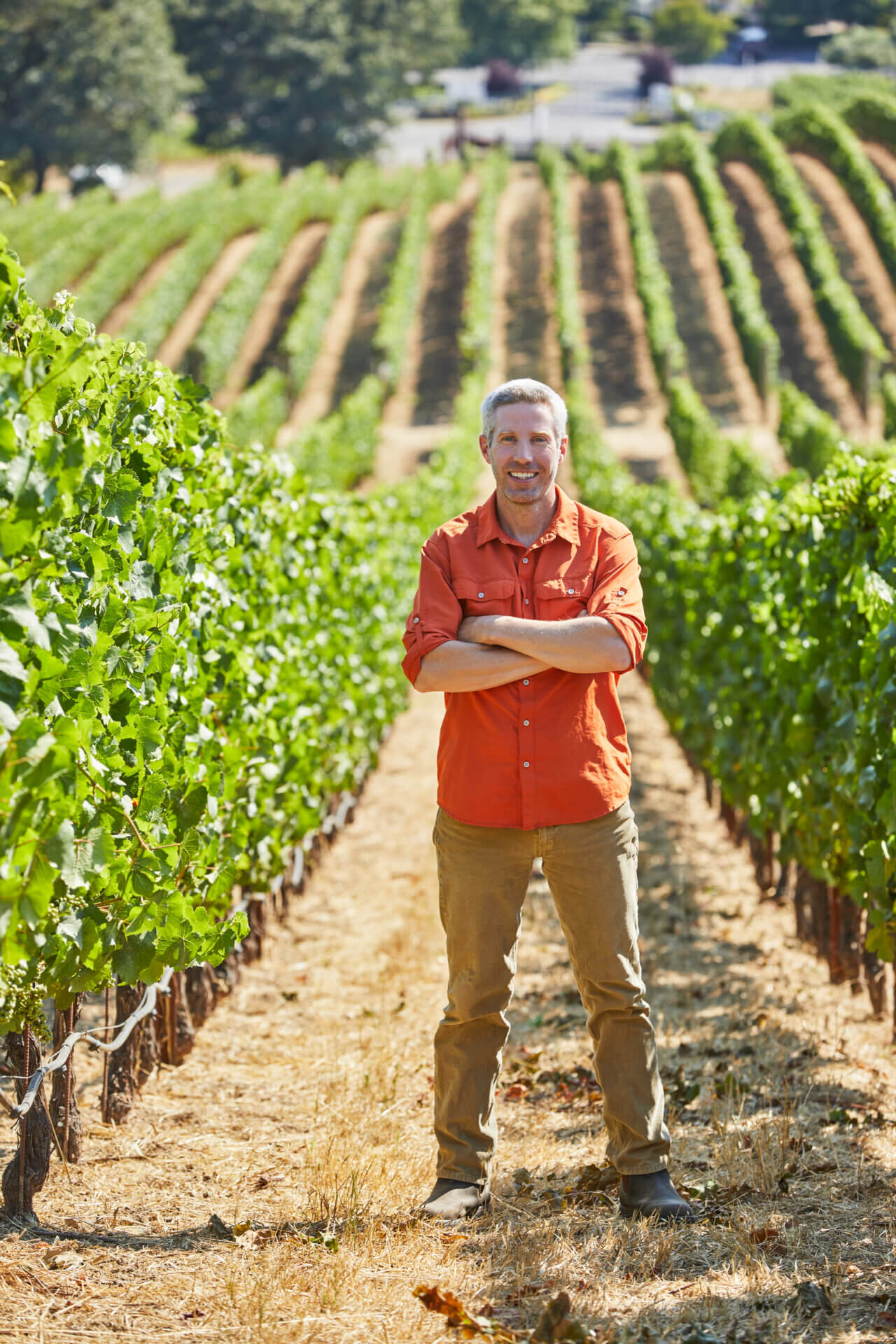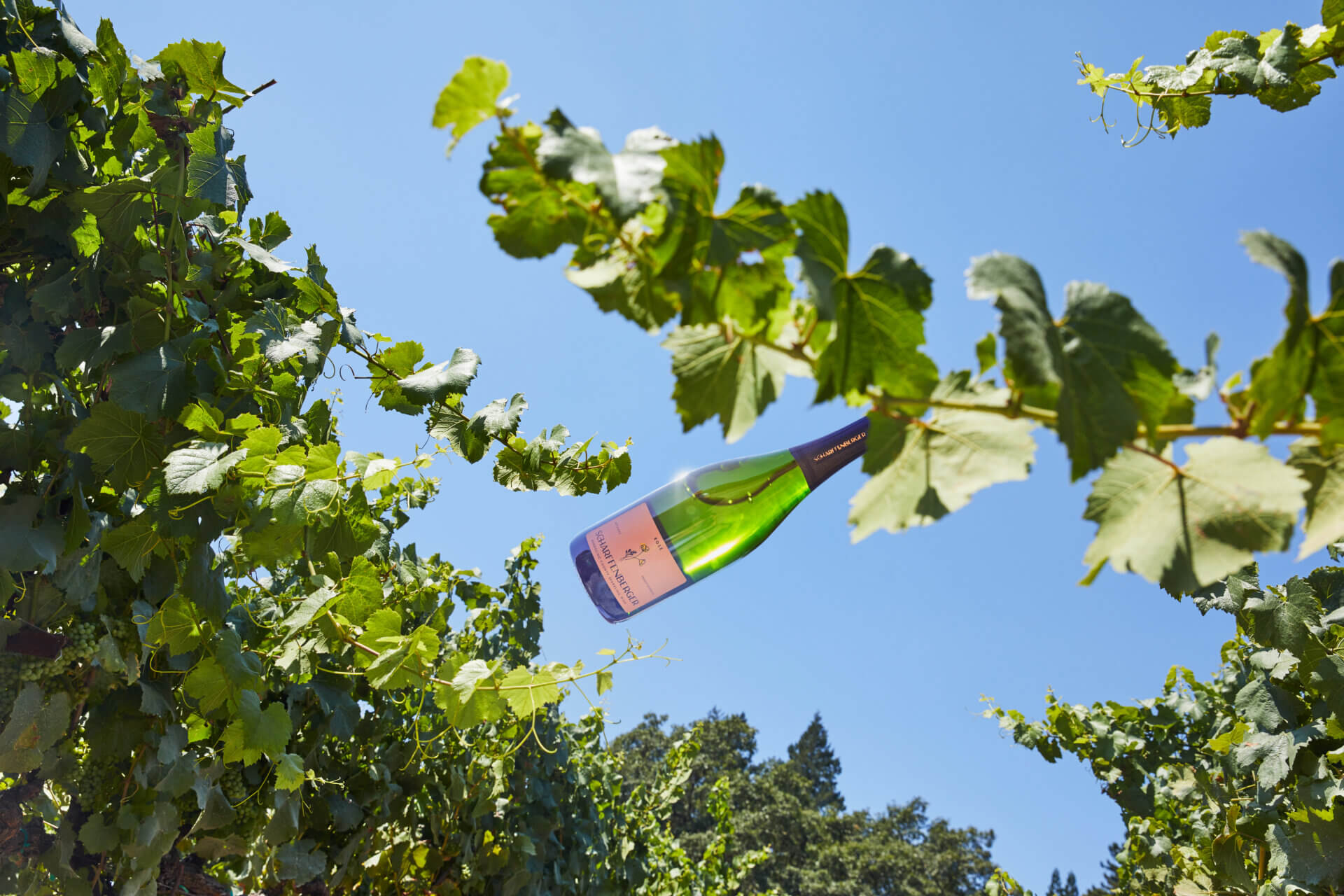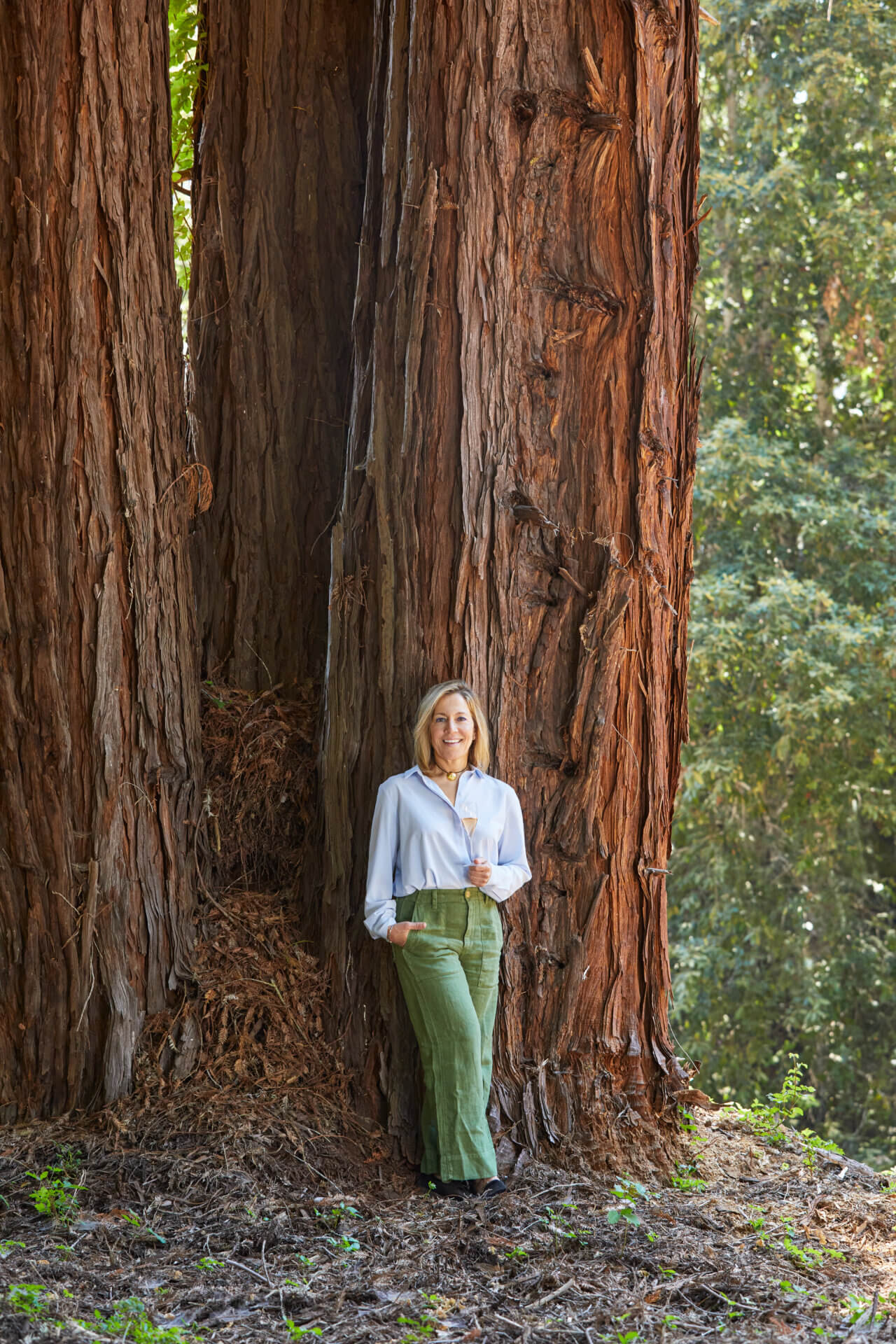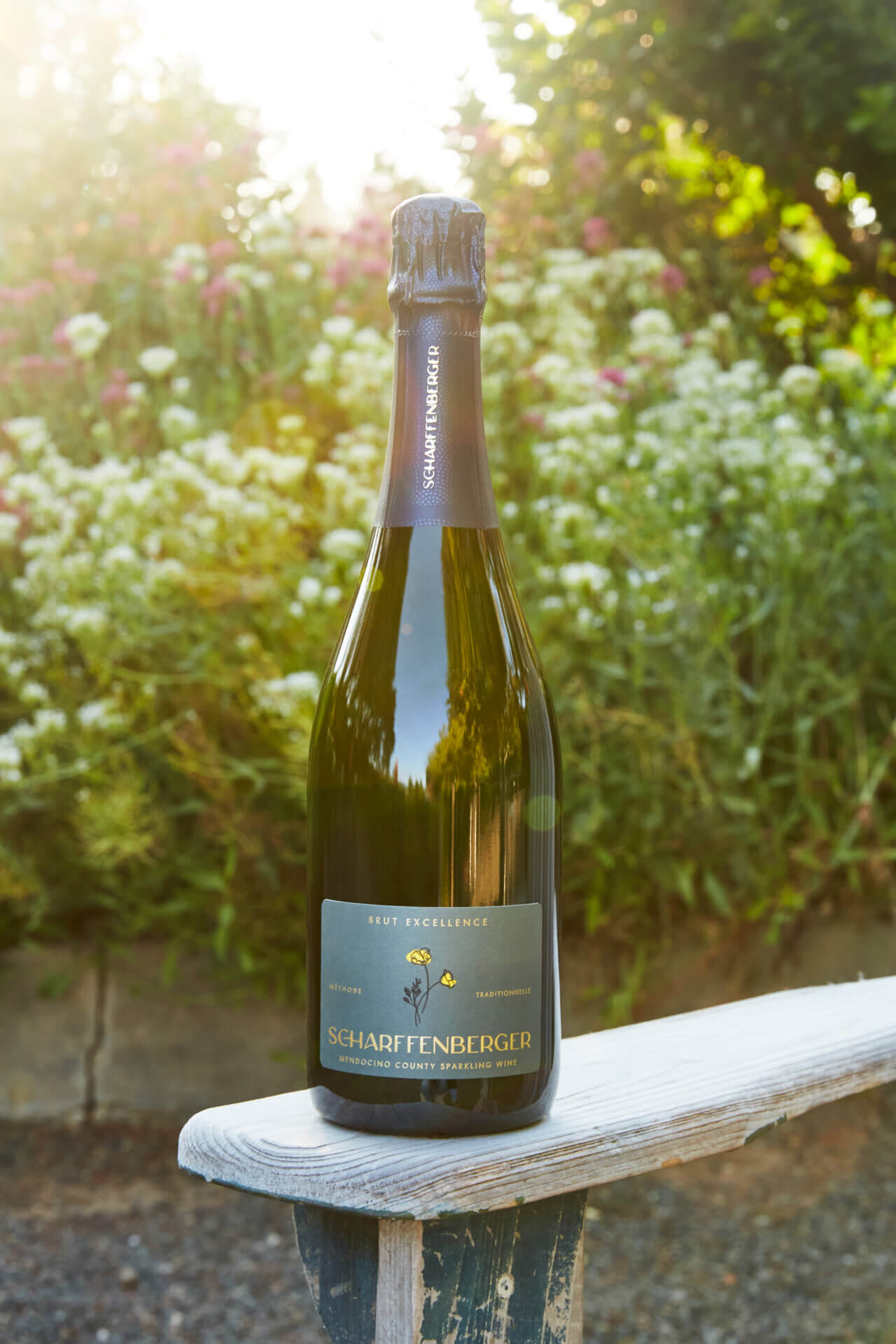WITH A REFRESHED LABEL, SCHARFFENBERGER CELLARS BLOSSOMS ANEW IN THE ANDERSON VALLEY
story by: Ruth Tobias photos by: Steph Meyers
Even by California’s high standards, the Scharffenberger Cellars estate in the Anderson Valley town of Philo is bucolic. Gently rolling hills surround the vineyards, walnut and pear trees grace the lawn in front of the winery, an English-style garden flourishes at the entrance to the tasting room, and blackberry bushes line the path to a redwood grove in the middle of it all. No wonder 63 of the property’s roughly 200 acres have been granted to the Anderson Valley Land Trust for conservation purposes, while another 120 are dedicated to the Pinot Noir and Chardonnay (along with about 1% Pinot Meunier) that, in the form of traditional-method sparkling wine, capture all that natural Mendocino County beauty in a bottle.
In November, Scharffenberger launched new packaging that’s “more in line with what we’re doing as a brand,” in winemaker Jeffrey Jindra’s words. The label is now simply adorned with a California poppy, “which in the springtime is littered throughout the vineyard here,” he explains. As the official state flower, “it’s iconic, it’s beautiful, and it has an elegance that speaks to our area and the quality of the wine.” It’s an emblem, in short, of what has been the producer’s mission since its founding 40-plus years ago: to establish “the paradigm of what sparkling [wine is] in California . . . not to be Champagne but to be Mendocino” as it conveys everyday luxury to the trade and consumers alike.

“The Beginning of Luxury”
As an all-around bon vivant in the late 1970s, John Scharffenberger had plenty of occasions to drink bubbly—and his impression of the domestic stuff at the time was, “well, not all that good,” says Jindra. So the University of California, Berkeley, graduate in biogeography—a self-designed discipline combining plant and soil sciences—got to work. “He looked at where the scene was, where people were planting, what they were doing, and kind of went against the grain. . . . He’d done some studies and visits to Champagne and, looking at maps and climate [patterns], he found that the Anderson Valley”—where commercial grape growing was still a new enterprise, according to Jindra—“would offer him an opportunity to pursue not just sparkling wine but world-class sparkling wine.”
Launching the brand in 1981 with a production facility in Ukiah, he achieved enough success early on to form a partnership with Champagne Pommery, which financed the 1991 purchase of the Philo property and the construction of the winery there. But in the wake of several ownership changes, the founder saw an opportunity to pursue other avenues, and eventually Scharffenberger was on the market.
Enter Champagne Louis Roederer. Given that its own sparkling-wine house in Philo, Roederer Estate, was already purchasing fruit from Scharffenberger, says Jindra, “it just made sense that Roederer would make an offer to acquire this property.” It did just that in 2004, purchasing the winery and the brand with the intention of restoring the equity. With that accomplished, he explains, “Now we’re making a push toward that next chapter [and creating] something that really fits in” with the rest of the French company’s portfolio while working to, in Roederer Collection president of U.S. wineries Nicole Carter’s words, “expand our points of distribution within the world of on-premise,” which represents a significant percentage of the brand’s business. Hence the refreshed label design: “Our idea was to premiumize these wines,” says Carter, adding that “people are always so surprised to find quality traditional-method at this price point,” which ranges from about $25 to $40. “It is important that we elevate what the consumer sees and what the buyer sees in the package. New packaging is always a conversation starter, it’s not the conversation ender, so the hope is to start new conversations.”

On that note, Carter continues, “It’s very important to us, to our philosophical approach, to provide a journey in sparkling wine that starts with an entry-level and takes you all the way up to prestige sparkling. We want to capture the imagination of the next generation of sparkling drinkers and keep them on that journey as they begin to graduate up in their flavor profiles when it comes to everything with bubbles. . . . Scharffenberger represents the entry point, so the quality is paramount to making sure they stay with us. . . . We all have those ‘aha’ moments in our wine journeys where all of a sudden your paradigm changes around what you like, what you can appreciate—you know that a shift has happened. Our goal with Scharffenberger is to be that first shift”—in other words, “the beginning of luxury.”

The Scharffenberger Style
They couldn’t have picked a better place to achieve it. “The nice thing is that, with the grapes that grow in this area, we’re able to have Old World finesse with New World fruit-forwardness,” says Jindra. That’s thanks in no small part to the diurnal temperature shifts of up to 50 degrees that occur in various parts of Mendocino County—Scharffenberger sources from other growers in the region in addition to cultivating its own grapes—whereby “that warm day bakes in fruit flavors but the cold night really preserves the acid,” as does morning fog that “brings a little blanket of cool, moist air, which grapes love,” Jindra adds. He also credits the area’s gravelly loam soils with small pockets of clay for “bring[ing] forward a wine that is dense with flavor but light on its feet. We have sought after plots that have well-drained soils with good water-holding capacity, allowing the roots to procure water and nutrients as needed throughout the growing season.”
Harvest typically starts in mid- to late August and continues through late September. “We end up pressing all of the juice,” Jindra explains, but “what we focus on is the cuvée fraction, [which] for us is the first 125 gallons per ton,” along with no more than 5% of the taille, or mid-cut (the rest gets sold off). After primary alcoholic fermentation, for “roughly 80% of the wines, we’re going to encourage malolactic fermentation to occur; [for] roughly 20%, we’re going to try to inhibit it. . . . We want something that’s going to be round, rich, California in style but also with a backbone and freshness, and that’s where that non-malo component can bring a bit of life to a blend.”
Speaking of blending, Jindra relies on “a panel of palates” during assemblage that includes colleagues from other Roederer Collection wineries. Working with his fellow winemakers allows him to “help push what we do to that next level [and] make that best representation of the brand,” with about 15% of each release being composed of solera-held reserve wine so that it “tells the story not only of that primary vintage [but] of all your vintages past,” in Jindra’s words. “Every year you’re adding that new layer and new point of interest to that overall conversation” while also maintaining consistency. Once blended and bottled, the wines spend a minimum of two and a half years en tirage and at least six months under cork after disgorgement.
Of the resulting wines, what Jindra calls Scharffenberger’s “foundation” are its Brut Excellence ($25) and Brut Rosé Excellence ($29). The former, a blend of 60% Chardonnay and 40% Pinot Noir, “has traditionally been the mainstay for the brand since its inception,” he notes. “Having something that is serious but approachable is a key element to what we’re doing, [and this] is very inviting. . . . It’s made in a malo style, so the aromatics become a little bit more coffee cream, hazelnut, and then you get the nice brioche tones from the time on the lees” along with ripe apple, Anjou pear, and hints of green melon. But with “a thirst for sparkling rosé on the rise,” in his words, the Rosé—composed of 55% Chardonnay and 45% Pinot Noir, of which about 5% is vinifed as red wine—has recently “moved into lead position and become the driver of our brand.” As he explains, “Pinot Noir has really risen to be the crown jewel of the Anderson Valley, and this is a way to showcase [its] nice berry fruit; the fact that it’s gone through malolactic fermentation also brings that nice creaminess, so it’s kind of like having berries and cream.” Strawberry shortcake and raspberry flecked with raspberry leaf lead the way on both the nose and the velvety yet clean, clearly etched palate, met by touches of orange, red apple, and rose.

Several other wines in Scharffenberger’s portfolio are sold DTC. Take the Brut Black Label ($30), which Jindra calls “a late-disgorged presentation of our classic Brut,” spending seven years on the lees. “This really just shows the benefit of having patience—it’s something that continues to build mouthfeel and [moves] away from the primary flavors [toward] more of the tertiary aromas and flavors, but what I find fascinating is how much more texture and sucrosity builds with this wine. As a result, we’ve scaled back the dosage level.” Aromas of pastry crust, almond cookie, and orchard fruit announce the blend of 63% Chardonnay and 37% Pinot Noir, which combines a glossy texture with lifting acidity amid flavors of lemon peel, peach, and coffee bean.
Then there’s the Scharffenberger Crémant ($26), a 50/50 blend of Chardonnay and Pinot Noir “that has been a staple here since well before my time,” says Jindra. Its name is a reference to its style: “It’s bottled at two-thirds of the pressure, so in the end there [are] fewer bubbles, which leads to a softer, creamier mouthfeel. . . . With the Pinot, [we’re allowing for] a little bit more skin extraction. . . . Because you’re macerating on the skins during the pressing cycle, [it] ultimately releases a little bit more of that fruit character. The pH is also slightly higher, so it feels softer as well. And then to finish it off . . . we’re at a dosage level that brings us into the extra dry category at 18 grams [of residual sugar], whereas everything else is averaging that 8- to 9-gram level here.” Pillow-soft the Crémant most certainly is, its creaminess underscored by a buttery note, yet there’s a firm freshness to the apple and pear fruit it carries along, accented by lime leaf.
Finally, the 2018 Blanc de Noirs ($40) marks not only Jindra’s first harvest at Scharffenberger but the return of vintage-dated wines to the lineup after a several-year hiatus. “In the years that warrant it, it’s something we’d like to continue to do to show the expression of a vintage and the quality of the fruit that comes from [it],” he notes (they also made a 2019 Blanc de Blancs). “But there’s no incentive to do it just to do it; it’s really about when the wine [is] above and beyond what an average year would produce.” In this case, he adds, “What I like about the wine is that each [component]”—namely 38% Pinot Noir, 36% Pinot Meunier, and 26% Pinot Gris—“is bringing something to the table,” with the Meunier delivering “a really big acid impact to the overall blend” while “the Pinot Gris is bringing an oily texture and also a little of those stone-fruit aromatics. And then the Pinot Noir really becomes the backbone—it’s the power, it’s the grace.” Undergoing no malolactic conversion, the elegant blend shows raw almond, toast, apricot, and apple on both the nose and a palate that conveys freshness as well as fullness thanks not least to crisp acidity and hints of lemon meringue.
Preparing for the Future
Whether 2023 will yield vintage wine remains to be seen. During harvest, which began on August 25, “the yields look[ed] promising and so [did] the quality—sugar, acid, and flavor have been in good places,” says Jindra. “But it is far too early to truly know what to expect. Generally these decisions are not finalized until all the cards are on the table; our assemblage process will start in February and it is not until then that we know how all the pieces fit together.”
In the long term, the team at Scharffenberger is continually making improvements in the vineyard, whether by choosing a greater variety of site-appropriate rootstocks and clones than were planted here in the past or by moving away from a “hard-to-manage” Geneva Double Curtain system toward “more of a vertical trellis and doing it with cane pruning instead of having a full established cordon and spurs,” in Jindra’s words. He adds that they’re also striving “to farm for the next generation.” While Roederer goes about converting its Anderson Valley properties to organic farming “where and when possible,” they’ve already achieved Fish Friendly Farming certification and are working on “bringing health to our soils through cover crops in the spring [and] reincorporating compost,” to which they add housemade biochar. Produced from fallen trees and pulled vines, “it provides nutrient-holding capacity and water-holding capacity, which brings life to your soil,” Jindra explains; adds Carter, “What I love is that . . . we’re creating that charcoal element from our own vine material and putting it back into the soil, so it’s a beautiful cyclical approach.”
Not to mention a means to a warm homecoming for those beloved poppies upon their return next spring—a gorgeous symbol of Scharffenberger Cellars’ own impending superbloom.
